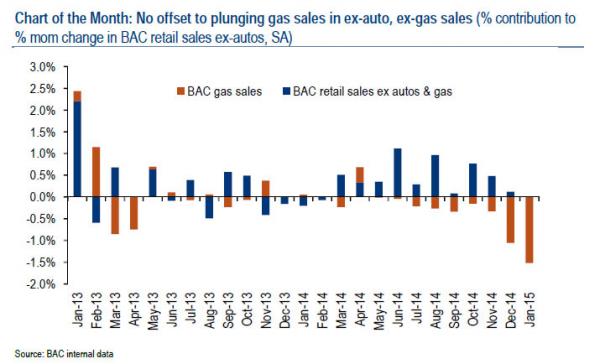One just has to laugh while reading the following hilarious attempt to justify the cognitive dissonance by Bank of America’s (BAC) analysts – and everyone else for that matter – who were oh so certain that tumbling (if not any more) gas prices would translate into a “splurge” of spending on non-gas related goods and instead, when looking at their internal data, are seeing something inexplicable.
To be sure, it wasn’t just BofA data that has shown a plunge in discretionary spending: the December retail sales report last month courtesy of the government showed precisely the same, even if BofA’s analysts – and everyone else – rushed to describe as a “one-off” aberration which would quickly be revised higher.
Well, it won’t be. Because while the BLS may seasonally adjusted and revise employment data to make the economy seem far stronger than it really is, when it comes to spending, every dollar leaving one pocket ends up in another pocket, and can thus be traced.
This is how Bank of America explains its total confusion why the US consumer so desperately refuses to follow the “recovery” script.
Getting impatient
All signs point to a robust consumer: job growth has accelerated, with an average of 336,000 jobs created a month over the prior three months, gasoline prices have plunged and interest rates have declined. Consumers are taking notice with sentiment measures climbing higher. According to the University of Michigan survey, consumers have not been this upbeat since January 2004, when the economy was booming. The natural outcome should be for consumers to splurge, hitting the malls and going out to restaurants. But much to our surprise, the data suggest otherwise.
The BAC internal data show little improvement in expenditures in January, even after netting out gasoline and autos. Sales ex-gasoline and autos, on BAC credit and debit cards, was unchanged mom SA and have slowed over the past few months (Chart of the Month). And it is not unique to our data – the Census Bureau painted a weaker picture with the December report (however, as we argue in this note, we think the risk is that core control sales are revised higher on Thursday).
How can we explain this disconnect? It seems that consumers are saving some of the windfall cash from lower gasoline prices, with the personal savings rate increasing to 4.9% in December. Another factor is that our data may be skewed by consumers with credit cards who are not as budget constrained as those who spend predominately with cash. Looking at a breakdown of spending by key sectors, we find a pick-up in sales at home improvement stores, restaurants and grocery stores, but a slowdown in lodging and furniture sales.
Â
Â


